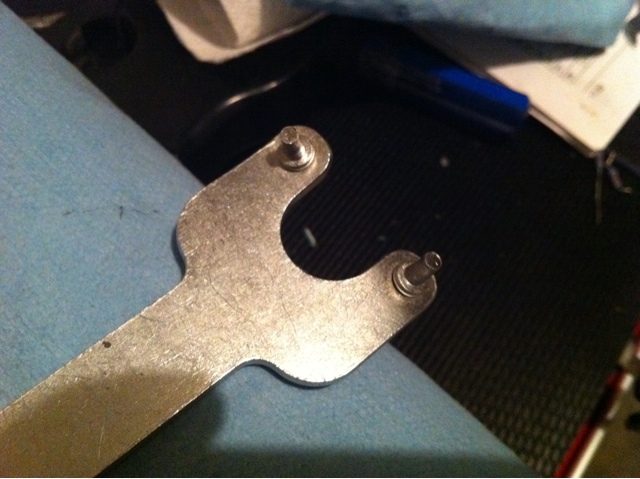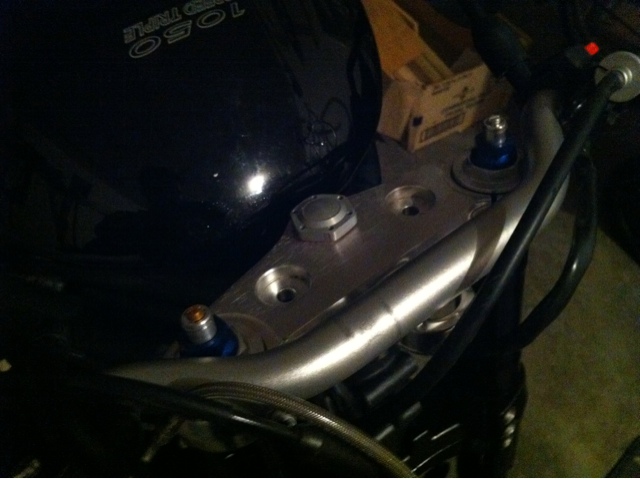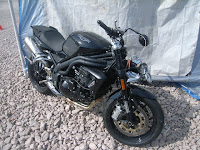This is going to be a rant, not a blog post. Came back home happy to have found a great contact for hacking up the top triple for fixing up the headlight. Ready to bring the top triple to get it sliced, I got to work in removing it off the bike. I didn't get very far...
Is it really required that manufacturers create proprietary tools for their machines? Would a large nut fixing the top triple to the tree not suffice??
My attempt at removal of the nut #1: mutilate my angle grinder pin spanner to fit the job. This required I stick in the vice and stretch the non-adjustable pins outward, and grind the pins down a size. With wheel between my knees I gave a heave, with result being a irreparably mangled spanner, bloody knuckle, and scratched nut (on the top triple!).
Attempt #2, I tried an adjustable wrench, with an effect of only further scratching up nut. I refuse to buy the specialized tool, an after licking off my wounds (to knuckle and ego) I will try a plain 38mm socket.
October 31, 2011
October 28, 2011
It's alive! It's ALIVE!
That's right, I've got the engine running, and what music to my ears! I will not mention the embarrassing last gaffe I had made... ok, let's just say I got all the complicated instrument wires right (puzzling wiring mentioned in last post), but then went color blind on red vs brown at the ignition switch.
I'll admit, I've been down in the garage a couple of recent evenings just to start her up and listen to that triple sound before hitting the sack. It made for good dreams.
This evening I spent some time on rough investigation on how I might be able to replace the instruments, which are in bad shape but seem to be required for starting the bike up. There are some wild theories/reports out there that the instruments can be replaced by placing a 120Ohm resistor across the KL (short for K & L lines of the ISO 9141 interconnect, also incorrectly referred to as the CAN bus) bus wires at the instrument, but have not seen a post that would confirm this for late Speed Triple, nor have I been able to do this on my bike.
On disconnecting the red and blue KL wires and placing a 120Ohm resistor in the instrument's place the bike will not start. This is apparent as soon as the engine kill is toggled since the fuel pump will not prime (no pleasing whirring sound from underneath the tank). Not only that but it seems some basic basic lights on the cluster such as N are also driven by the KL; ie this advanced bus is not limited to fancy metrics like fuel consumption etc.
I think I may be erring towards reusing the roughed-up but function original cluster is version 1.0 of the bike. Should be easier to get it safetied this way too.
I'll admit, I've been down in the garage a couple of recent evenings just to start her up and listen to that triple sound before hitting the sack. It made for good dreams.
This evening I spent some time on rough investigation on how I might be able to replace the instruments, which are in bad shape but seem to be required for starting the bike up. There are some wild theories/reports out there that the instruments can be replaced by placing a 120Ohm resistor across the KL (short for K & L lines of the ISO 9141 interconnect, also incorrectly referred to as the CAN bus) bus wires at the instrument, but have not seen a post that would confirm this for late Speed Triple, nor have I been able to do this on my bike.
On disconnecting the red and blue KL wires and placing a 120Ohm resistor in the instrument's place the bike will not start. This is apparent as soon as the engine kill is toggled since the fuel pump will not prime (no pleasing whirring sound from underneath the tank). Not only that but it seems some basic basic lights on the cluster such as N are also driven by the KL; ie this advanced bus is not limited to fancy metrics like fuel consumption etc.
I think I may be erring towards reusing the roughed-up but function original cluster is version 1.0 of the bike. Should be easier to get it safetied this way too.
October 23, 2011
Too good to be true?
And that's exactly what went through my head as I received an email that I had the winning bid, and that it's been approved by the seller. I did fetch the bike for a song, but I wasn't fooling myself since I can imagine in most cases these machines land in the salvage yard for a good reason. In this case, judging from the dead odometer (and 0 / NA in listing's mileage), it was clear that the bike's electricals were shot. The kicker is that in modern bike electricals are digital, ie the engine management system, and fancy safety and security features.
For example, as I did my research waiting for the bike to arrive by freight I learned that the bike's instrument cluster was part of the digital Controller Area Network (CAN, a standard common in modern vehicles), and with these disconnected the bike would not even power up. Guess what?! It was clear from the pics that the instruments on mine had been sheared off in the crash! Note, I believe that the communication protocol on these modern Triumph is technical not CAN but the ISO 9141-2; I think it may be just a case of overly broad use of the 'CAN' term.
As I got into learning about all the fancy aspects of vehicle electronics, brushing off my knowledge of digital electronics, it did not occur to me how different work with vehicle electricals is and how little experience I have in this domain. I've included a copy of the main wiring diagram; quite a feat if you consider that it needs to be correlated with several other more detailed diagrams, wires are not uniquely identified by their color (4 black wires coming out of instruments, item 1 on diagram!), and the order in which the wires are crimped into connectors doesn't necessarily follow the connectors conventions (again the connector on the instruments). The second shot in the post is the instrument connector, where the black wire at bottom is in fact wire 1 and not 8 as marked on the connector.
Well, long story short and a couple of fuses later, I can say I'm just about there in getting the bike started. I've fixed a couple of other items around the bike and now cleared all the engine codes (w/ ISO9141 dongle & tuneecu, more in later posts). As I hot wire the bike (busted ignition switch ;) ) and flick the engine switch all kinds of fuel-priming, actuator-whirring sounds are coming from under the tank, but as the starter relay flick on I get no action out of the starter motor. Almost!
Oh, and the last shot shows the odometer reading which confirmed my suspicion that the bike is practically brand new. 6082mi is not even a season's riding!
October 17, 2011
Catching up to do
Quick introduction: this blog is an running account of my salvaging a beautiful Triumph Speed Triple from a NC yard. This actually began couple months ago as I spotted the bike. Having got a fair way into the restore I realized how i should be documenting this for myself and others that may be interested. And so the first few posts will be a retro-account of what I've done so far.
Here are a few from when I first spotted her in the online salvage listing. Note it seems in really good shape, but more on that in a later post.
Subscribe to:
Posts (Atom)








